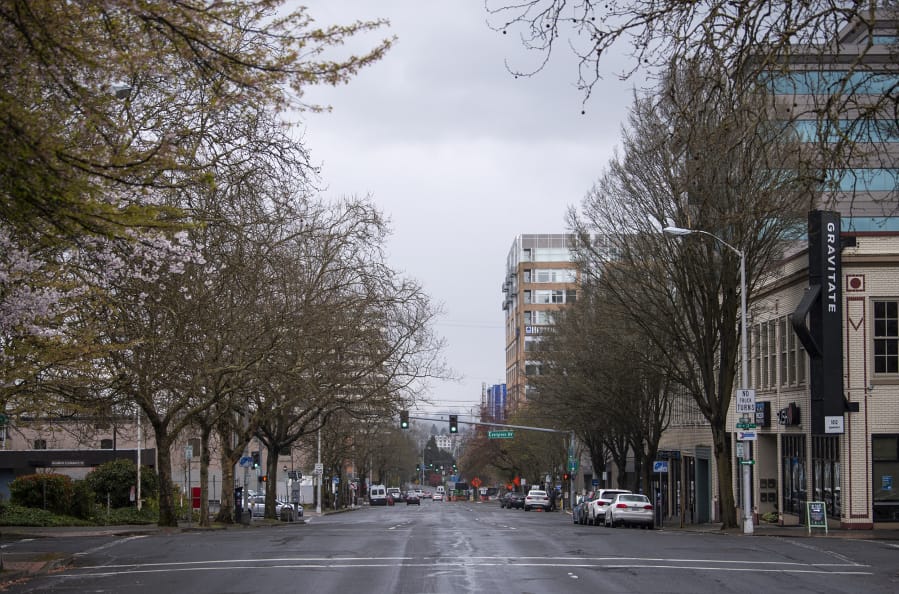The number of unemployment claims in Clark County last week spiked by 1,575 percent compared with the week before, signaling the first set of employment impacts from the COVID-19 outbreak.
In the week ending March 14, the number of unemployment claims in the county sat steady at 373, about even with prior weeks this year. But the week ending March 21 showed a total of 6,249 unemployment insurance claims, according to the Washington Employment Security Department.
Suzi LeVine, the department’s commissioner, said Thursday that state unemployment claims were five times higher last week than they were during the worst week of the Great Recession in December 2008. Nationally, nearly 3.3 million Americans applied for unemployment benefits last week — almost five times the previous record set in 1982.
The “velocity and volume” of the COVID-19 unemployment crisis, LeVine said, amounts to the single most extreme event ever faced in the state office’s 90-year history.
Across the Columbia River, where approximately 70,000 Clark County employees commute to work, Oregon saw a similarly dramatic spike in claims. The Oregon Employment Department reported more than 76,500 initial claims last week, up from 4,900 just the previous week.
“We knew it was going to be a big number,” said Scott Bailey, regional economist for Southwest Washington. “It’s humongous.”
Clark County had a higher increase than the state as a whole, which saw an 843 percent increase. Spokane County had the largest increase, at 1,826 percent.
The unemployment insurance claims have come from every industry across the state, said Bailey. Some, including agriculture, aren’t as affected. But others, such as hospitality and hotels, have seen large amounts of unemployment claims, signaling mass layoffs.
Statewide, former employees of the accommodation and food services industry filed 41,309 new claims, up 1,033 percent from the previous week, according to the Washington Employment Security Department. Health care and social assistance had 18,902 new claims; retail trade had 8,700 new claims, and manufacturing had 5,276 new claims.
“A lot of people are losing their jobs, and across the board,” Bailey said.
The state will release new claims numbers April 2, and Bailey said that he expects the following week to be higher, especially after Gov. Jay Inslee made a clarification on Thursday morning to exclude most construction from a list of essential workers who can work during the outbreak.
Bailey’s prediction tracks with what Steven Ross, ESD’s director of labor market information, is anticipating he’ll see in the coming weeks.
“There’s a lot of random variability in what we’re seeing, because we have nothing to compare it to,” Ross said Thursday morning, That said, he added: “It has not peaked yet.”
To handle the unprecedented spike in claims, the state employment office is adding staff, especially to its customer service department, LeVine said. She estimated that ESD would add between 500 and 1,000 temporary and permanent workers before the crisis passes. Anyone interested in working for the department can find out more at esd.wa.gov/esdjobs.
In order to make unemployment insurance more accessible to more people, ESD has also relaxed some qualifications that people might usually need to show to qualify for benefits.
The mandatory one-week waiting period, for example, has been waived. Work search requirements — a stipulation that recipients of unemployment benefits show they’ve applied for three jobs per week — are now optional. And part-time employees now qualify for standby status, or a temporary unemployment benefit contingent on a return-to-work date that was previously only open to full-time workers. Gig economy workers may also now qualify for standby status on a case-by-case basis.
These rules are new, and ESD is working to update its online database while dealing with a tenfold increase in website traffic. It’s possible that some claimants had received a rejection letter in error last week.
Claims officers have been and will continue to follow up with those people in the coming weeks, said Dan Zeitlin, ESD’s director of Policy, Data, Performance and Integrity.
“Washington has fairly generous unemployment compensation,” said Bailey. “With federal aid on top of that, it should be a pretty big help for people who are losing their jobs.”
The details of how the nearly $2 trillion federal aid package passed by the Senate on Wednesday night — which would send households up to $1,200 in direct aid for every adult, and $500 for each child — would impact state-level unemployment are still in flux. But it’s unlikely that the payout from the Federal Treasury will reduce or otherwise count against a recipient’s state unemployment benefits, Zeitlin said.





